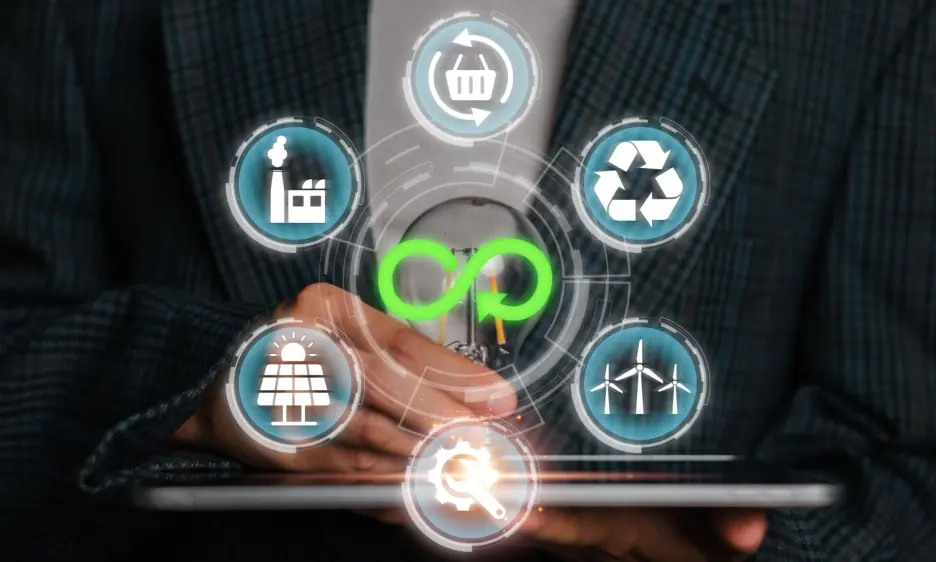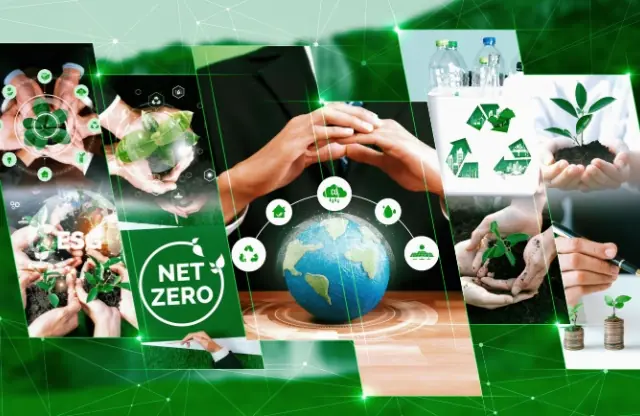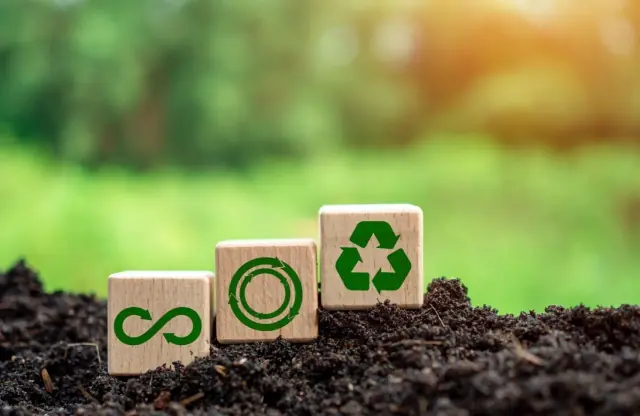Circular Business Model: The Path To Sustainable Growth And Reporting
 Share
Share
 Copy Url
Copy Url

A circular business model is a smart, sustainable approach that many companies are adopting to reduce waste and maximize the use of resources. At its core, the circular business model operates like a closed loop system, ensuring that products and materials remain in use for as long as possible. But what is a circular business model? It’s a model that moves away from the traditional “take-make-dispose” mindset, focusing instead on regenerating resources within the circular economy. This system helps businesses improve their sustainability efforts while reducing their environmental footprint. The World Economic Forum has championed the importance of circularity in the value chain, helping businesses rethink how they manage their product life cycles. By understanding the different types of circular business models, companies can optimize resources and reduce waste.
This article will dive into key topics such as understanding the circular business model, its benefits, and the different types of circular business models available. We will also explore how businesses can implement these models for sustainability reporting and how they contribute to long-term sustainability. Ready to find out how a circular business model can reshape your operations? Let’s get started!

Understanding the Circular Business Model
A circular business model focuses on minimizing waste and maximizing resource use. Unlike the linear model of "take, make, dispose," it encourages continuous use of materials through repair, recycling, and reuse, creating a closed-loop system. This approach benefits businesses while reducing their environmental impact and aligning with sustainability goals. The model plays a vital role in promoting the circular economy, which aims to extend product life and optimize the value chain. In this section, we'll cover its key principles, differences from linear models, and more.
Definition and Key Principles
A circular business model focuses on keeping resources in use for as long as possible by recovering, reusing, and recycling materials. Some core principles include:
- Product Design for Longevity: Products are designed to last longer and can be easily repaired, refurbished, or recycled.
- Resource Recovery: Waste materials are reintegrated into production, creating a loop that minimizes the need for new raw materials.
- Sharing Platforms: Companies offer services rather than ownership (e.g., leasing), reducing the need for constant product production.
- Circular Supply Chains: Businesses collaborate with stakeholders to create closed-loop supply chains that focus on waste reduction and resource reuse.
- Value Retention: Maximizing the value of products over their lifecycle through maintenance, upgrades, and recycling.
Differences Between Circular and Linear Models
The circular business model differs significantly from the linear model. Key differences include:
- Resource Use: Circular models focus on resource reuse, while linear models rely on the continuous extraction of raw materials.
- Waste Management: Circular systems minimize waste through recycling, whereas linear models lead to higher waste output.
- Product Lifecycle: Products in a circular system are designed for durability and repair, unlike the linear approach where products are often disposable.
- Supply Chain: Circular models foster collaborative supply chains, focusing on sustainability, while linear models focus on profit maximization without considering long-term impacts.
- Sustainability Integration: Circular models embed sustainability at every stage, while linear models do not prioritize it.
The Role of Sustainability in Circular Business
Sustainability is central to the circular business model. It ensures that businesses reduce their environmental impact by making better use of resources and extending product lifespans. Additionally, this model helps companies meet ESG goals and align with global sustainability reporting standards. By reducing waste and emissions, businesses can avoid greenwashing claims and show genuine commitment to sustainability.
Common Industries Adopting Circular Models
Several industries have adopted the circular approach:
- Fashion: Companies are focusing on textile recycling and creating reusable clothing lines.
- Technology: Tech firms are designing products for repairability and offering refurbishment services.
- Automotive: The industry is using recycled materials and promoting car-sharing platforms.
- Food: Businesses are tackling food waste through upcycling and circular economy approaches to plastic waste.
- Construction: Construction companies are using recycled materials and designing buildings for disassembly and reuse.
Examples of Successful Circular Business Models
In India, several companies have implemented successful circular models:
- Tata Steel: They focus on recycling steel waste and incorporating it back into production.
- Mahindra: Mahindra Reva's electric vehicles are designed for durability and use recyclable materials.
- Godrej Appliances: They run take-back programs for old appliances, refurbishing and reselling them.
- Aditya Birla Fashion: The company promotes sustainable fashion by recycling textiles and reducing waste.
- ITC Limited: ITC’s Paperboards and Specialty Papers Division uses waste materials to manufacture paper, integrating recycling and reuse into the supply chain.
The circular business model is an innovative approach that can help companies create a more sustainable future. By focusing on resource efficiency, waste reduction, and collaboration across the value chain, businesses can improve their sustainability performance while maintaining profitability and compliance with global standards.

Key Benefits of a Circular Business Model
The circular business model offers great benefits for businesses that want to improve sustainability and make better use of resources. By focusing on reusing, repairing, and recycling, companies can lower their environmental impact and still increase profits. Let’s look at the main benefits of adopting this model and how it aligns with sustainability goals.
Reduction of Waste and Resource Efficiency
The circular business model cuts waste by keeping materials in use for longer. This reduces the need for new raw materials and decreases reliance on finite resources. By using cradle-to-cradle design and strong waste management systems, businesses can recycle more and send less to landfills, helping the environment.
Cost Savings and Operational Efficiency
Using circular practices helps businesses save money. It reduces the costs of raw materials, energy, and waste disposal. Better use of products and more efficient supply chains also boost productivity, lowering production costs and supporting a more sustainable economy.
Enhanced Brand Reputation
Adopting a circular business model shows a commitment to sustainability, which boosts a company's reputation. Customers and stakeholders prefer responsible businesses. Reducing waste and encouraging reuse can build customer loyalty and attract new clients, improving the company’s public image.
Compliance with Sustainability Regulations
With stricter environmental laws worldwide, the circular model helps businesses meet sustainability reporting requirements. This proactive approach helps companies avoid penalties and prepares them for future regulations. It also aligns with long-term environmental goals and strengthens business operations.
Innovation and Competitive Advantage
The circular model promotes innovation by encouraging new ways to use resources and design products. Businesses can offer product-as-a-service options or extend product lifespans, giving them a competitive edge. This opens new market opportunities and makes them leaders in the circular economy.
The circular business model provides clear benefits for sustainability-focused businesses. From reducing waste to boosting innovation, it creates a more efficient and responsible system that benefits both the planet and the company's bottom line.

Types of Circular Business Models
Circular business models are innovative approaches that focus on sustainability by keeping resources in use for as long as possible. These models help businesses cut down on waste and improve resource efficiency by integrating principles of the circular economy. Below are some key types of circular business models that companies are adopting:
1. Circular Input Model
This model focuses on using renewable or recycled materials in production. It reduces reliance on virgin resources, helping businesses cut costs and reduce waste. This approach is beneficial across industries that rely on scarce materials and is a core part of the stages of the usage cycle.
2. Product Life Extension Model
Businesses using this model focus on prolonging the lifespan of products through repair, maintenance, or upgrades. By extending product life, they reduce the need for new resources and decrease waste, contributing to a circular economy approach to plastic waste and other materials.
3. Product-as-a-Service Model
In this model, companies keep ownership of products and offer them as services instead of selling them. Customers pay for the service, while businesses handle maintenance and repairs, promoting product longevity. This model supports a sustainable way of doing business, aligning with a transition to a circular economy goals.
4. Sharing Platforms
Sharing platforms enable businesses to maximize resource use by allowing several customers to access products or services. This model is common in industries like transportation and housing (e.g., car-sharing services), helping reduce the need for new products.
5. Resource Recovery Model
This model focuses on reclaiming materials from end-of-life products to be reused or recycled. By capturing value from what would otherwise become waste, companies reduce their environmental footprint and lower costs associated with disposal.
These circular business models provide various ways for companies to reduce waste, cut costs, and create more sustainable business practices. By adopting these models, businesses can benefit from improved resource efficiency, innovation, and enhanced reputation, all while contributing to a more sustainable future.

Implementing Circular Business Models for Sustainability Reporting
Implementing a circular business model requires tracking progress and ensuring that businesses meet sustainability goals. Sustainability reporting plays a key role in showcasing these efforts and helps companies communicate their impact. Below, we cover the role of sustainability reporting in circular models, along with the associated challenges and metrics.
The Role of Sustainability Reporting
Sustainability reporting helps businesses track and communicate their circular practices, showing their progress in reducing environmental impact. It ensures that companies remain accountable and can share their efforts with stakeholders. Reporting also highlights how a business adheres to the principles of the circular economy, enabling companies to engage with consumers and investors seeking sustainable brands.
Metrics and KPIs for Circular Business Models
Accurate sustainability reporting depends on key metrics that measure a company’s circularity. Some critical metrics include:
- Material Circularity: Measures the percentage of materials that are recycled or reused across the production cycle.
- Water Circularity: Tracks how water is recycled and reused in operations, essential for industries with high water usage.
- Renewable Energy Use: Measures the proportion of renewable energy sources used, which reduces the business’s reliance on fossil fuels.
- Greenhouse Gas (GHG) Impact: Quantifies the emissions from production processes, highlighting reductions in carbon footprint.
- Product Lifespan: Evaluates how long products last before disposal, focusing on extending product life through repair and reuse.
Challenges in Reporting Circular Practices
Reporting on circular business models can be complex due to several challenges:
- Data Collection: Gathering data on resource use and waste throughout the value chain is challenging and often involves third parties.
- Granularity of Data: Circular reporting requires detailed data across all stages of production, which is often difficult to track and measure.
- Lack of Standardization: Many industries lack consistent frameworks for circular reporting, making it hard to compare results across sectors.
- Integration with Financial Reporting: Aligning circular metrics with traditional financial KPIs can be difficult, particularly for businesses transitioning from linear models.
- Double Materiality: Companies must assess both their financial and environmental impacts, which requires a dual focus on ecological and social costs.
Transparency in Circular Business Practices
Being transparent about circular operations builds trust with industry leaders and stakeholders. Sharing strategies allows businesses to show their impact on the environment and commitment to sustainability. Transparent reporting reduces the risk of greenwashing and strengthens credibility. Especially under scrutiny from regulators and investors.
Aligning Circular Strategies with Reporting Standards
To ensure circular initiatives align with global standards, businesses can use frameworks like the Global Reporting Initiative (GRI) and the Sustainability Accounting Standards Board (SASB), the latter which was created by the International Sustainability Standards Board (ISSB). These frameworks provide guidelines for tracking and reporting circularity. They help businesses stay compliant and set clear targets for their circular performance.
Implementing and reporting on a circular business model is crucial for companies aiming to lead in sustainability. By using the right metrics and overcoming challenges, businesses can track progress, maintain transparency, and align with global standards. This supports a circular economy approach to plastic waste and other sustainability efforts, ensuring long-term success.

How a Circular Business Model Contributes to Long-term Sustainability
Adopting a circular business model plays a vital role in fostering long-term sustainability by reducing waste, enhancing resource efficiency, and building resilience. This approach ensures that businesses thrive while minimizing their environmental and social impacts. Below, we explore its contributions to sustainability in different areas.
Environmental Impact and Climate Change
A circular business model positively impacts the environment by reducing waste and extending the life of materials through recycling, reuse, and remanufacturing. This reduces the need for new raw materials, which helps lower greenhouse gas emissions. Circular practices can address up to 45% of global emissions. Thus contributing significantly to climate change mitigation. Businesses that reduce waste and avoid unnecessary resource extraction help preserve ecosystems and lessen their ecological and social costs.
Economic Resilience and Long-term Profitability
Resource Efficiency
Circular businesses cut costs by recycling and reusing materials, reducing their need for raw materials. This stabilizes supply chains and shields businesses from price fluctuations.
Product Longevity
Designing durable, repairable products extends their lifecycle. This reduces replacement needs and creates opportunities for maintenance services, generating steady revenue.
Diversified Revenue Streams
Models like product-as-a-service generate recurring revenue by charging for usage rather than ownership. This helps businesses remain profitable during economic downturns.
Lower Operational Costs
Minimizing waste and optimizing resources lowers operational costs. Practices like remanufacturing reduce expenses, boosting profitability.
Stronger Customer Relationships
Offering services like repair and refurbishment builds customer loyalty, enhances brand reputation, and encourages repeat business.
Social Responsibility and Ethical Business
Circular business models promote social responsibility by encouraging ethical practices. These include fair labor, waste reduction, and the use of renewable resources. Prioritizing sustainability helps companies improve the environment and livelihoods. Especially in communities affected by resource extraction. This approach aligns with ethical standards, lowers social costs, and enhances their reputations among business leaders and consumers.
Future Trends in Circular Business and Sustainability
Digital Integration
Technologies like blockchain and IoT help track product lifecycles. This boosts transparency and improves recycling processes.
Product-as-a-Service Models
More businesses are adopting pay-per-use models. This increases resource efficiency and creates long-term revenue.
Advanced Recycling Technologies
New recycling methods allow businesses to process complex materials. In turn, they increase material recovery and reduce the need for new resources.
Remanufacturing and Refurbishment
The trend of remanufacturing products in sectors like electronics and automotive supports sustainability by reducing waste and lowering material costs.
Circular Supply Chains
Businesses are prioritizing circular supply chains that focus on material reuse and recycling. This ensures a more sustainable production process.
Adopting a circular business model helps companies reduce their environmental impact, increase their economic resilience, and enhance social responsibility. Circular practices continue to evolve. This means businesses will have to get more innovative in contributing to long-term sustainability and drive future growth.

Scalability of Circular Business Practices: Scope in India
Scaling circular business models in India has strong potential for long-term sustainability. This can happen by adopting innovations in resource management, extending product lifecycles, and reducing waste. Efficient use of resources helps businesses lower environmental impact while boosting economic benefits. With India's growing population and urbanization, these practices can also strengthen stability and resilience in the economy.
For Indian businesses, scaling requires integrating circular practices into key sectors like manufacturing, agriculture, and textiles. The sustainable business model promotes reusing materials, recycling products, and designing for durability. This approach reduces waste, cuts costs, and generates new income streams. By 2050, these strategies could bring economic benefits of over USD 624 billion. Circular practices will also keep Indian businesses globally competitive, driving opportunities for innovation across industries.
Adopting circular models aligns businesses with ethical standards and global sustainability goals, aiding India's shift toward a cleaner, greener economy. By embedding circularity in their operations, businesses can ensure long-term growth and sustainability while remaining resilient.

Scaling Sustainability with Report Yak
Embracing a circular business model is key to fostering long-term sustainability. Reducing waste, enhancing resource efficiency, and aligning with ethical standards can significantly improve a business's environmental impact. These practices also drive innovation and increase profitability. At Report Yak, we help you showcase these efforts through world-class sustainability reports, ESG reports, and more.
Explore our LACP award-winning reports, that you'll find in our Portfolio, to see how we’ve helped businesses communicate their sustainability journey. Besides sustainability and ESG reports, we design annual reports, impact reports, integrated reports, and other corporate reports to meet all your reporting needs.
For more information, visit the Services section on our website. You can reach us at contact@reportyak.com, WhatsApp, call 1800 121 5955 (India), or simply fill out our Contact Form, and we’ll respond promptly.
Related Posts
-
How To Adopt BRSR Guidelines For Success
Oct 15, 2025Share
Copy Url
Simplifying ESG Disclosure for Better Impact
corporate reportingenvironmental and social initiatives
+6
Aug 28, 2025Share
Copy Url
GRI Sustainability Taxonomy: Learn How to Turn Data Into Advantage
corporate governancecorporate reporting
+11
Jul 1, 2025Share
Copy Url


